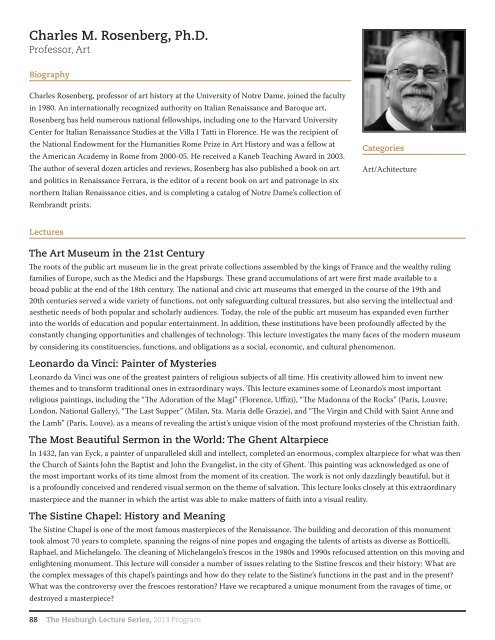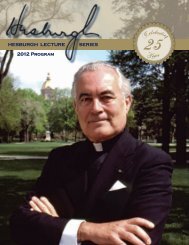HESBURGH LECTURE SERIES 2013 Program - Alumni Association ...
HESBURGH LECTURE SERIES 2013 Program - Alumni Association ...
HESBURGH LECTURE SERIES 2013 Program - Alumni Association ...
Create successful ePaper yourself
Turn your PDF publications into a flip-book with our unique Google optimized e-Paper software.
Charles M. Rosenberg, Ph.D.<br />
Professor, Art<br />
Biography<br />
Charles Rosenberg, professor of art history at the University of Notre Dame, joined the faculty<br />
in 1980. An internationally recognized authority on Italian Renaissance and Baroque art,<br />
Rosenberg has held numerous national fellowships, including one to the Harvard University<br />
Center for Italian Renaissance Studies at the Villa I Tatti in Florence. He was the recipient of<br />
the National Endowment for the Humanities Rome Prize in Art History and was a fellow at<br />
the American Academy in Rome from 2000-05. He received a Kaneb Teaching Award in 2003.<br />
The author of several dozen articles and reviews, Rosenberg has also published a book on art<br />
and politics in Renaissance Ferrara, is the editor of a recent book on art and patronage in six<br />
northern Italian Renaissance cities, and is completing a catalog of Notre Dame’s collection of<br />
Rembrandt prints.<br />
Lectures<br />
The Art Museum in the 21st Century<br />
The roots of the public art museum lie in the great private collections assembled by the kings of France and the wealthy ruling<br />
families of Europe, such as the Medici and the Hapsburgs. These grand accumulations of art were first made available to a<br />
broad public at the end of the 18th century. The national and civic art museums that emerged in the course of the 19th and<br />
20th centuries served a wide variety of functions, not only safeguarding cultural treasures, but also serving the intellectual and<br />
aesthetic needs of both popular and scholarly audiences. Today, the role of the public art museum has expanded even further<br />
into the worlds of education and popular entertainment. In addition, these institutions have been profoundly affected by the<br />
constantly changing opportunities and challenges of technology. This lecture investigates the many faces of the modern museum<br />
by considering its constituencies, functions, and obligations as a social, economic, and cultural phenomenon.<br />
Leonardo da Vinci: Painter of Mysteries<br />
Leonardo da Vinci was one of the greatest painters of religious subjects of all time. His creativity allowed him to invent new<br />
themes and to transform traditional ones in extraordinary ways. This lecture examines some of Leonardo’s most important<br />
religious paintings, including the “The Adoration of the Magi” (Florence, Uffizi), “The Madonna of the Rocks” (Paris, Louvre;<br />
London, National Gallery), “The Last Supper” (Milan, Sta. Maria delle Grazie), and “The Virgin and Child with Saint Anne and<br />
the Lamb” (Paris, Louve), as a means of revealing the artist’s unique vision of the most profound mysteries of the Christian faith.<br />
The Most Beautiful Sermon in the World: The Ghent Altarpiece<br />
In 1432, Jan van Eyck, a painter of unparalleled skill and intellect, completed an enormous, complex altarpiece for what was then<br />
the Church of Saints John the Baptist and John the Evangelist, in the city of Ghent. This painting was acknowledged as one of<br />
the most important works of its time almost from the moment of its creation. The work is not only dazzlingly beautiful, but it<br />
is a profoundly conceived and rendered visual sermon on the theme of salvation. This lecture looks closely at this extraordinary<br />
masterpiece and the manner in which the artist was able to make matters of faith into a visual reality.<br />
The Sistine Chapel: History and Meaning<br />
The Sistine Chapel is one of the most famous masterpieces of the Renaissance. The building and decoration of this monument<br />
took almost 70 years to complete, spanning the reigns of nine popes and engaging the talents of artists as diverse as Botticelli,<br />
Raphael, and Michelangelo. The cleaning of Michelangelo’s frescos in the 1980s and 1990s refocused attention on this moving and<br />
enlightening monument. This lecture will consider a number of issues relating to the Sistine frescos and their history: What are<br />
the complex messages of this chapel’s paintings and how do they relate to the Sistine’s functions in the past and in the present?<br />
What was the controversy over the frescoes restoration? Have we recaptured a unique monument from the ravages of time, or<br />
destroyed a masterpiece?<br />
88 The Hesburgh Lecture Series, <strong>2013</strong> <strong>Program</strong><br />
Categories<br />
Art/Achitecture



